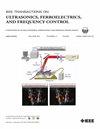TinyProbe: A Wearable 32-Channel Multimodal Wireless Ultrasound Probe
IF 3
2区 工程技术
Q1 ACOUSTICS
IEEE transactions on ultrasonics, ferroelectrics, and frequency control
Pub Date : 2024-11-12
DOI:10.1109/TUFFC.2024.3496474
引用次数: 0
Abstract
The need for continuous monitoring of cardiorespiratory activity, blood pressure, bladder, muscle motion analysis, and more is pushing for research and development of wearable ultrasound (US) devices. In this context, there is a critical need for highly configurable, energy-efficient wearable US systems with wireless access to raw data and long battery life. Previous exploratory works have primarily relied on bulky commercial research systems or custom-built prototypes with limited and narrowly focused field applicability. This article presents TinyProbe, a novel multimodal wearable US platform. TinyProbe integrates a 32-channel US receive (RX)/transmit (TX) front-end, including TX beamforming (TinyProbe:穿戴式 32 通道多模式无线超声探头
对心肺活动、血压、膀胱、肌肉运动分析等进行连续监测的需求推动了可穿戴超声设备的研发。在这种情况下,亟需可无线访问原始数据且电池寿命长的高配置、高能效可穿戴超声系统。以往的探索性工作主要依赖于笨重的商业研究系统或定制原型,这些系统的现场适用性有限且范围狭窄。本文介绍的 TINYPROBE 是一种新型多模态可穿戴超声平台。TINYPROBE 集成了 32 通道超声波 RX/TX 前端,包括 TX 波束成形(64 Vpp 激发,16 个延迟曲线)和模数转换(高达 30 Msps,10 位),以及用于无线原始数据访问的 WiFi 链接(21.6 Mbps,UDP),所有这些都采用紧凑(57 × 35 × 20 毫米)、轻巧(35 克)的设计。TINYPROBE 采用先进的省电技术和优化的电子设计,在成像模式(32 通道,33 Hz)下功耗小于 1W,在高PRF 多普勒模式(2 通道,1400 Hz)下功耗小于 1.3W。这使得无线 US 系统的能效达到了最先进的 44.9 mW/Mbps,确保了使用 500 mAh 锂聚合物电池就能工作多小时。我们在肌肉和膀胱成像以及血流速度测量等多个体内成像场景中验证了 TINYPROBE 是一种多功能、通用型可穿戴平台。
本文章由计算机程序翻译,如有差异,请以英文原文为准。
求助全文
约1分钟内获得全文
求助全文
来源期刊
CiteScore
7.70
自引率
16.70%
发文量
583
审稿时长
4.5 months
期刊介绍:
IEEE Transactions on Ultrasonics, Ferroelectrics and Frequency Control includes the theory, technology, materials, and applications relating to: (1) the generation, transmission, and detection of ultrasonic waves and related phenomena; (2) medical ultrasound, including hyperthermia, bioeffects, tissue characterization and imaging; (3) ferroelectric, piezoelectric, and piezomagnetic materials, including crystals, polycrystalline solids, films, polymers, and composites; (4) frequency control, timing and time distribution, including crystal oscillators and other means of classical frequency control, and atomic, molecular and laser frequency control standards. Areas of interest range from fundamental studies to the design and/or applications of devices and systems.

 求助内容:
求助内容: 应助结果提醒方式:
应助结果提醒方式:


